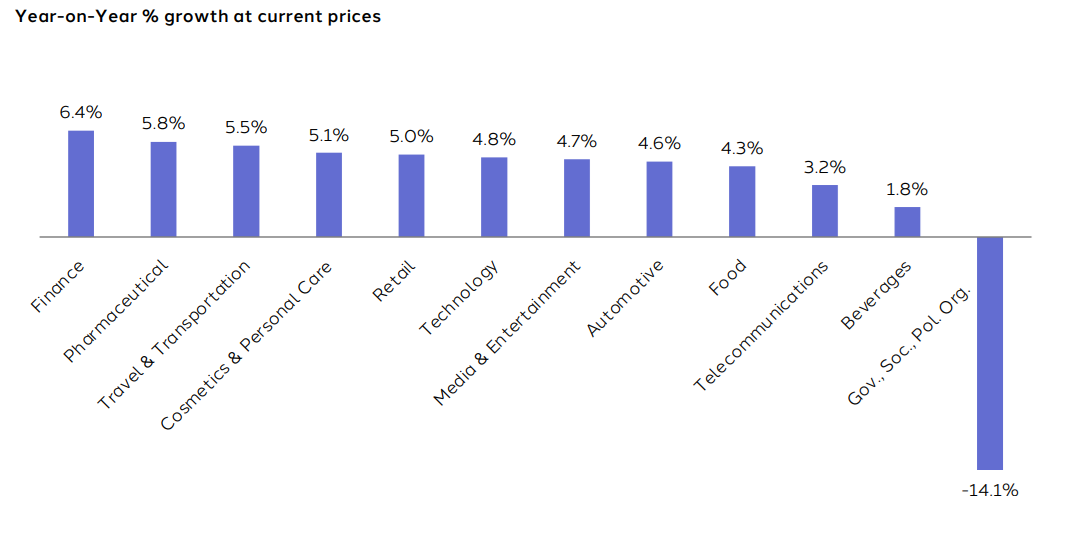In the latest report from Dentsu, global advertising spending is forecast to grow by 5.9% in 2025, far exceeding the global economic growth rate of 3.2%. In particular, advertising spending is expected to be driven by prominent trends such as: Digital, Retail Media, Connected TV, etc. In particular, algorithmic factors will significantly change the advertising market in the coming years, opening up outstanding opportunities and not small challenges. Let’s explore the advertising trends of 2025, the advertising channels that will reign and the industries that are investing the most in advertising in the report below!
Overview of the potential Advertising market in 2025
According to the latest forecast from the IMS Monetary Fund, the global economy will grow by 3.2% in both 2024 and 2025. In addition, the rate of price inflation has also slowed down, making market prices is gradually entering a more stable state. Therefore, up to 89% of CMOs predict marketing budgets will increase next year along with the growth of the economy and media is considered an important lever to drive business growth. for businesses.
Previously, 2024 was considered a golden time for the advertising market, when a series of global events such as the Euro and the Olympic Games took place promoting investment by brands. This causes advertising spending in 2024 to explode strongly, twice the rate of global economic growth.
However, by 2025, it is expected that the growth rate of advertising spending will slow down to 5.9%, because there are not too many major events taking place at this time. But compared to the growth rate of the economy, advertising spending is still growing quite positively. Particularly for the Asia-Pacific region, including the Vietnamese market, advertising spending is expected to increase by 5.4% in 2024 and 5.8% in 2025, reaching 253.4 billion. dollars.
Especially forms such as Retail Media, Paid Search, Paid Advertising on social networks,… will continue to attract more budget from brands.
Enter the era of Algorithmic Advertising
2025 is considered by marketing experts to be the year of the era of algorithmic advertising. Nowadays, from entertainment information to shopping trends that we are experiencing on Digital channels are all managed by algorithms. Algorithms will decide to distribute appropriate content to consumers and automatically remove poor quality content that is not suitable for the algorithm. Therefore, algorithmic optimization is greatly affecting the effectiveness of advertising.
According to Dentsu, the popularity of algorithms will continue to grow stronger in 2025, and by 2027 approximately 79% of reported spending will be driven by algorithms. However, the popularity of algorithmic advertising also leads to a situation where the advertising market becomes uncreative when everyone uses the same algorithm in the same way. For example, content marketers often follow identical advertising content frames in the hope of achieving the most optimal advertising.
This is both a challenge and an opportunity for brands to create a highlight in a market tamed by algorithms. To do that, brands need to avoid using familiar algorithmic optimization models, while tapping into consumers’ curiosity and taking advantage of desired preferences. In particular, brands should be bold and test new forms of advertising to make a difference and avoid boredom for consumers.

Forecast Spending by each Industry
Advertising spending also fluctuates strongly by industry. In particular, the financial (6.4%) and pharmaceutical (5.8%) sectors are forecast to have very strong advertising spending growth in 2025.
For the financial sector, the increase in advertising spending came from the recovery of insurance companies. Meanwhile, in the pharmaceutical sector, advertising spending is rising as consumers are increasingly demanding healthcare solutions and medical treatments.
Some other industries such as tourism and transportation will also grow quite impressively, about 5.5% by 2025. Cosmetics and personal care products will also grow by 5.1%, and the retail industry will increase. grew 5.5%, Technology increased 4.8% and Media Entertainment increased 4.7%. In general, all industries recorded positive growth in advertising spending in 2025. Only the government sector, social and political organizations reduced advertising spending after a booming 2024. Exploding spending from elections.

Forecast spending by each media channel
#1. Digital advertising continues to grow strongly
In 2025, digital ad spending is expected to grow 9.2% (three-year CAGR of 8.8% to 2027) accounting for 62.7% of the total ad market.
Retail Media
In 2025, digital advertising will continue to be one of the leading channels in the advertising market with a growth rate of 9.2% and accounting for 62.7% of the total advertising market. Among current Digital Marketing channels, Retail Media is the channel with the fastest growth rate, expected to grow 2.1% by 2025.

Paid Scial – Paid Social Network
Paid advertising on social networks also grew quite positively, about 8.7%. By 2025, this type of advertising will be driven by diverse features, from shopping, short videos, search, to gaming entertainment on social networking sites. In particular, this is still one of the very important channels for brands to reach young consumers.
Paid Search – Paid Advertising on Search Engines
Along with paid advertising on Social Media, paid advertising on search engines will also grow quite positively at about 6.7% in 2025.
In particular, AI tools play a very important role in promoting the development and increasing the influence of search engines, making them more and more relevant and bringing a better experience to users. This is an essential factor for search engines to retain users as they are gradually shifting to social networking sites and retailers’ platforms.
Short content continues to be popular
Short content types on social networking sites such as Instagram and TikTok will continue to grow strongly in 2025. This is the type of advertising most favored by many CMOs, with up to 45% of CMOs sharing that they will increase spending on short content.
Program Sponsorship
Sponsorship of programs will continue to be the type of advertising with the largest spending among digital advertising channels. It is expected that this advertising channel will grow to 11.1% by 2025 and continue to grow steadily in the long term.

#2. Retail Media changes the advertising spend hierarchy
Retail Media is understood as a form of advertising from retailers when they take advantage of their platform and data to provide advertising space for brands. Currently, Retail Media is receiving a lot of attention in the advertising market, because retailers often possess very deep data systems and the ability to reach users, thereby allowing advertisers and merchants to The signal can be targeted very precisely.
For example, payment solutions Brand PayPal is a financial services provider to consumers, but it has also leveraged its vast payments network to offer advertising services. Thereby, they allow other brands to reach users through PayPal’s platforms. Or CVS Pharmacy recently partnered with The Trade Desk to build a self-service advertising system across the brand’s platforms.
With advantages in data and platform, Retail Media is expected to create a new boom in the near future. Up to 87% of CMOs stated that they intend to maintain or increase their spending on Retail Media over the next 12 months.
#3. TV advertising shifts to Connected Television
TV advertising returned to growth in 2024 (+1.6%), after nearly two years of decline. This strong growth result is thanks to the election and major global sporting events such as UEFA Euro and the Olympic and Paralympic Games. Therefore, it is expected that advertising spending for television will only maintain a growth rate of 0.6% in 2025. Because in 2025 there will not be too many big events that can attract the attention of a large number of consumers. used globally like last year.
There are two main types of television advertising: Connected Television and Broadcast Television. Broadcast Television can be roughly understood as traditional channels such as radio or television programs. Connected Television refers to television devices that are connected to the Internet, thereby allowing people to watch Video and music content, as well as browse the web.
In 2025, it is expected that spending on Broadcast Television will decrease by about 2.5%. However, this will still be the channel that accounts for a large proportion of television advertising with the ability to attract a large audience during major events.
Meanwhile, Connected Television will continue to grow at a double-digit rate of about 18.4% by 2025. One of the factors driving this strong growth is streaming platforms like Netflix and Netflix. Prime Video is gradually expanding their advertising services. In addition, online sports events also play a very important role in the development of Connected Television channel.
In general, advertising on Connected Television will continue to grow stronger in the near future and may explode more strongly than Broadcast Television. Because young consumers today prefer online channels. Only about 24.5% of Gen Z watch live TV every day, this number has dropped significantly compared to 50.1% of Gen X.

#4. Other platforms such as OOH, Postcard & Radio continue to increase
Press:
Advertising spending for newspaper channels will decrease slightly by about 2.5% by 2025. However, this will still be a very important channel in fields that require authoritative, scholarly content. as high as law, politics, etc. In particular, brands will focus more on digital newspaper channels, pushing advertising spending on these channels to increase by about 0.6%. In contrast, spending on traditional print newspapers will decrease by about 4.3%.
OOH:
Outdoor advertising is expected to grow about 3.9% by 2025. Traditional OOH still accounts for the majority of global advertising spending in some major advertising markets. In addition, new types of Digital OOH are also growing strongly, thereby boosting overall spending on OOH channels. It is expected that OOH will soon surpass print by 2026 with total projected spending of $46.2 billion versus $44.1 billion, respectively.
Podcasts & Radio
Spending on audio advertising has shown signs of recovery with a growth rate of about 1.8% by 2025. In particular, the Postcast channel is growing very positively, expected to be about 5.3% by 2025. 2025. Retailers are also leveraging the proximity of radio channels to enhance the consumer experience at the point of sale. In addition, audio advertising such as radio and Postcast is also a very potential channel to advertise political issues in some localities and countries around the world. These dynamics have helped the influence of Postcast and radio in particular and audio advertising in general to increase.
Sustainability is becoming increasingly important in the advertising industry
Besides the outstanding trends in media channels and each industry, there is another special factor that is also attracting attention in the advertising industry: Sustainability. Sustainability in advertising is being expressed in many diverse forms, from promoting sustainable products to efforts to reduce carbon emissions from advertising activities. Typically, spending on electric car advertising increased by 9% compared to last year.
In particular, CMOs also expressed special interest in sustainable elements in advertising. 45% of respondents stated that their businesses have taken action to reduce carbon emissions from media activities, 47% are considering taking action, and only 8% said they have no intention of doing so. intend to act for sustainability. And up to 26 media outlets are also creating business plans that include sustainable development goals.
Comment Policy: We truly value your comments and appreciate the time you take to share your thoughts and feedback with us.
Note: Comments that are identified as spam or purely promotional will be removed.
To enhance your commenting experience, consider creating a Gravatar account. By adding an avatar and using the same e-mail here, your comments will feature a unique and recognizable avatar, making it easier for other members to identify you.
Please use a valid e-mail address so you can receive notifications when your comments receive replies.
